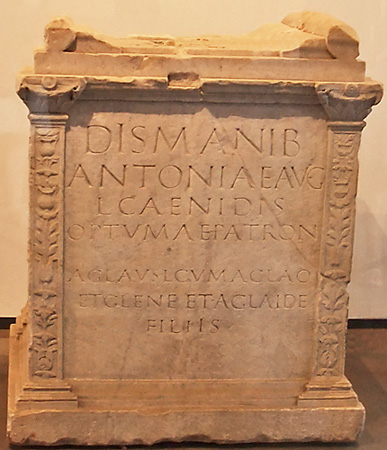
Funerary marble altar, 1st century CE

Caenis, as intelligent as she was resourceful, spent her entire life avoiding publicity. So little is known about her that every scrap of evidence bearing the name Caenis is closely examined (see Ancient Sources below). Of unknown origins, she is thought to have been born toward the end of the principate of Augustus (d. 14 CE). She was a slave of Antonia the Younger, the daughter of Marc Antony and Augustus' sister Octavia. Trained as a secretary, she figures in an anecdote that the 2nd century CE Roman historian and statesman Dio Cassius repeats about Antonia's role in the downfall of Sejanus, Tiberius' ambitious prefect of the Praetorian Guard. Whether it is an accurate record of Antonia's involvement or not, the story is a flattering portrayal of Caenis as a truthful, discreet and loyal servant. Her name, Antonia Caenis, indicates that she was freed either during Antonia's lifetime or in her will at her death in 37 CE. It has been suggested that the unmarried soldier Vespasian (19-79 CE), who was close to Antonia, began his long love affair with Caenis while she was still a slave. Suetonius notes that after the death of his wife and before he became emperor, Vespasian resumed their relationship (Suetonius calls it contubernium, a military term signifying cohabitation) which could not in Roman law be marriage. A freedwoman, she was like no other woman of the freed class. Widely known and acknowledged as the concubine of the Emperor Vespasian, she was rumored to have great influence over him, which she used with his knowledge for their mutual profit. Nevertheless, no acknowledged portrait of her survives (consider the individualized head of Victory on this aureus of Vespasian) and her name appears only four times in the literature. Through astuteness and discretion no doubt learned as a slave in the imperial house, she survived the dangerous political intrigues under successive emperors from Tiberius to Vespasian. She died a wealthy property owner in 74/5 CE, in the villa where she had lived quietly. This graceful and expensive funerary altar, found on her estate on the Via Nomentana near the Porta Nomentana, was expensively carved on all four sides (see left and right) and dedicated, surprisingly, by her freedman and his children. A recreation of Caenis' life based on the surviving texts is the acclaimed novel The Course of Honour.
ANCIENT SOURCES: Suetonius, Vita Divi Vespasiani 3.3, Vita Divi Vespasiani 21; Vita Domitiani 12.3.3; Dio Cassius, Historia Romae 64.1-4; Funerary inscriptions: CIL 6.4057; CIL 6.6607; CIL 6. 18358; CIL 20950.
Click on the underlined words for translation aids and commentary, which will appear in a small window. Click on the icon link
![]() to the right of the line for related images.
to the right of the line for related images.